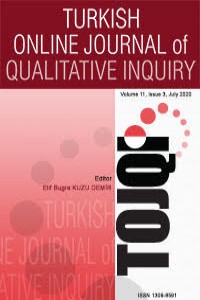Abstract
References
- den Brok, P. (2018, October). Quantitative methods in research on learning environments: An overview of past research and future trends. Paper presented at the the 1st International Conference on Critical Debates in Social Sciences, İzmir, Turkey.
- Fisher, D. L., & Fraser, B.J. (1981). Validity and use of My Class Inventory. Science Education, 65, 145–156. doi: 10.1002/sce.3730650206
- Fraser, B. J. (2002). Learning environments research: Yesterday, today and tomorrow. In S. W. Goh and M. S. Khine (Eds),Studies in educational learning environments: an international perspective (pp. 1-25). Singapore: World Scientific.
- Fisher D. L., & Fraser B. J. (April, 1990). Validity and use of the school-level environment questionnaire. Paper presented at the Annual Meeting of the American Educational Research Association, Boston, MA. Retrieved from http://files.eric.ed.gov/fulltext/ED318757.pdf
- Fraser, B. J. (April, 1981). Validity and use of individualized classroom environment questionnaire. Paper presented at the Annual Meeting of the American Educational Research Association, Los Angeles, CA. Retrieved from http://files.eric.ed.gov/fulltext/ED204351.pdf
- Fraser, B.J., & Treagust, D.F., & Dennis, N.C. (1986). Development of an instrument for assessing classroom psychosocial environment in universities and colleges. Studies in Higher Education, 11(1), 43-54. doi: 10.1080/03075078612331378451
- Lincoln, Y & Guba, E 1985, Naturalistic inquiry, Sage, Beverly Hills, CA.Moos, R. H. (1979). Evaluating educational environments: Procedures, measures, findings and policy implications. San Francisco: Jossey-Bass.
- Taylor, P.C., Fraser, B.J. & Fisher, D.L. (1997). Monitoring constructivist classroom learning environments. International Journal of Educational Research, 27, 293–302. https://doi.org/10.1016/S0883-0355(97)90011-2
- Trickett, E., & Moos, R. (1973). Social environment of junior high and high schools. Journal of Educational Psychology, 65, 93-102
- Walberg, H. J. (1968), Structural and affective aspects of classroom climate. Psychologhy in The Schools, 5, 247–253. doi:10.1002/1520-6807(196807)5:3<247::AID-PITS2310050309>3.0.CO;2-R
- Walberg, H. J. (1968), Structural and affective aspects of classroom climate. Psychologhy in The Schools, 5, 247–253. doi:10.1002/1520-6807(196807)5:3<247::AID-PITS2310050309>3.0.CO;2-R
Abstract
The literature provides perspectives in relation to the links between student perceptions of learning environment and their cognitive and affective outcomes but falls short in qualitatively explaining what teachers’ perceptions are in relation to classroom learning environment and its various characteristics. Hence, this study aimed to investigate teachers’ perceptions about learning environment characteristics facilitative to students’ outcomes and their conceptualizations concerning the term “learning environment”. The study was designed as basic qualitative descriptive research and attempted to elicit qualitative data from eight social sciences teachers working at state secondary schools. The results revealed that teachers had a tendency to conceptualize learning environment as a physical construct at first. Some of them also mentioned the social and psychosocial connotations or dimensions of the term. Three group of factors in the learning environment (categorized as physical, social and classroom assessment-based) were reported to be facilitative to student outcomes by the participants of this study.
References
- den Brok, P. (2018, October). Quantitative methods in research on learning environments: An overview of past research and future trends. Paper presented at the the 1st International Conference on Critical Debates in Social Sciences, İzmir, Turkey.
- Fisher, D. L., & Fraser, B.J. (1981). Validity and use of My Class Inventory. Science Education, 65, 145–156. doi: 10.1002/sce.3730650206
- Fraser, B. J. (2002). Learning environments research: Yesterday, today and tomorrow. In S. W. Goh and M. S. Khine (Eds),Studies in educational learning environments: an international perspective (pp. 1-25). Singapore: World Scientific.
- Fisher D. L., & Fraser B. J. (April, 1990). Validity and use of the school-level environment questionnaire. Paper presented at the Annual Meeting of the American Educational Research Association, Boston, MA. Retrieved from http://files.eric.ed.gov/fulltext/ED318757.pdf
- Fraser, B. J. (April, 1981). Validity and use of individualized classroom environment questionnaire. Paper presented at the Annual Meeting of the American Educational Research Association, Los Angeles, CA. Retrieved from http://files.eric.ed.gov/fulltext/ED204351.pdf
- Fraser, B.J., & Treagust, D.F., & Dennis, N.C. (1986). Development of an instrument for assessing classroom psychosocial environment in universities and colleges. Studies in Higher Education, 11(1), 43-54. doi: 10.1080/03075078612331378451
- Lincoln, Y & Guba, E 1985, Naturalistic inquiry, Sage, Beverly Hills, CA.Moos, R. H. (1979). Evaluating educational environments: Procedures, measures, findings and policy implications. San Francisco: Jossey-Bass.
- Taylor, P.C., Fraser, B.J. & Fisher, D.L. (1997). Monitoring constructivist classroom learning environments. International Journal of Educational Research, 27, 293–302. https://doi.org/10.1016/S0883-0355(97)90011-2
- Trickett, E., & Moos, R. (1973). Social environment of junior high and high schools. Journal of Educational Psychology, 65, 93-102
- Walberg, H. J. (1968), Structural and affective aspects of classroom climate. Psychologhy in The Schools, 5, 247–253. doi:10.1002/1520-6807(196807)5:3<247::AID-PITS2310050309>3.0.CO;2-R
- Walberg, H. J. (1968), Structural and affective aspects of classroom climate. Psychologhy in The Schools, 5, 247–253. doi:10.1002/1520-6807(196807)5:3<247::AID-PITS2310050309>3.0.CO;2-R
Details
| Primary Language | English |
|---|---|
| Journal Section | Articles |
| Authors | |
| Publication Date | July 30, 2020 |
| Submission Date | December 9, 2019 |
| Published in Issue | Year 2020 Volume: 11 Issue: 3 |

